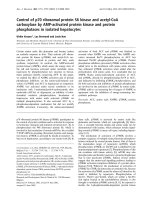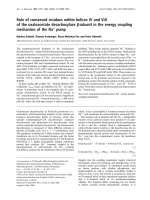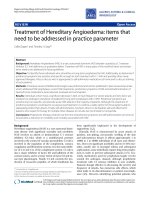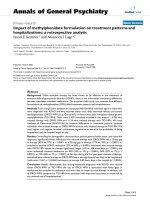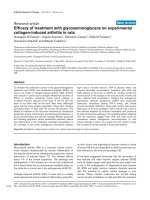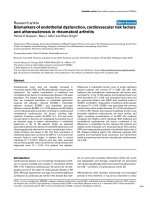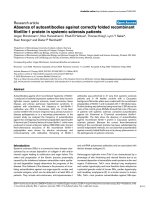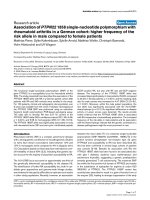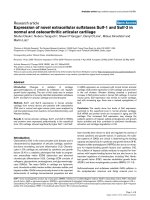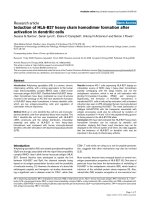Báo cáo y học: "Overview of the diagnostic value of biochemical markers of liver fibrosis (FibroTest, HCV FibroSure) and necrosis (ActiTest) in patients with chronic hepatitis C" doc
Bạn đang xem bản rút gọn của tài liệu. Xem và tải ngay bản đầy đủ của tài liệu tại đây (371.35 KB, 12 trang )
BioMed Central
Page 1 of 12
(page number not for citation purposes)
Comparative Hepatology
Open Access
Research
Overview of the diagnostic value of biochemical markers of liver
fibrosis (FibroTest, HCV FibroSure) and necrosis (ActiTest) in
patients with chronic hepatitis C
Thierry Poynard*, Françoise Imbert-Bismut, Mona Munteanu,
Djamila Messous, Robert P Myers, Dominique Thabut, Vlad Ratziu,
Anne Mercadier, Yves Benhamou and Bernard Hainque
Address: Groupe Hospitalier Pitié-Salpêtrière, 47-83 Boulevard de l'Hôpital, 75651 Paris Cedex 13, France
Email: Thierry Poynard* - ; Françoise Imbert-Bismut - ;
Mona Munteanu - ; Djamila Messous - ; Robert P Myers - ;
Dominique Thabut - ; Vlad Ratziu - ; Anne Mercadier - ;
Yves Benhamou - ; Bernard Hainque -
* Corresponding author
Summary
Background: Recent studies strongly suggest that due to the limitations and risks of biopsy, as well as the improvement of the
diagnostic accuracy of biochemical markers, liver biopsy should no longer be considered mandatory in patients with chronic
hepatitis C. In 2001, FibroTest ActiTest (FT-AT), a panel of biochemical markers, was found to have high diagnostic value for
fibrosis (FT range 0.00–1.00) and necroinflammatory histological activity (AT range 0.00–1.00). The aim was to summarize the
diagnostic value of these tests from the scientific literature; to respond to frequently asked questions by performing original new
analyses (including the range of diagnostic values, a comparison with other markers, the impact of genotype and viral load, and
the diagnostic value in intermediate levels of injury); and to develop a system of conversion between the biochemical and biopsy
estimates of liver injury.
Results: A total of 16 publications were identified. An integrated database was constructed using 1,570 individual data, to which
applied analytical recommendations. The control group consisted of 300 prospectively studied blood donors. For the diagnosis
of significant fibrosis by the METAVIR scoring system, the areas under the receiver operating characteristics curves (AUROC)
ranged from 0.73 to 0.87. For the diagnosis of significant histological activity, the AUROCs ranged from 0.75 to 0.86. At a cut
off of 0.31, the FT negative predictive value for excluding significant fibrosis (prevalence 0.31) was 91%. At a cut off of 0.36, the
ActiTest negative predictive value for excluding significant necrosis (prevalence 0.41) was 85%. In three studies there was a
direct comparison in the same patients of FT versus other biochemical markers, including hyaluronic acid, the Forns index, and
the APRI index. All the comparisons favored FT (P < 0.05). There were no differences between the AUROCs of FT-AT
according to genotype or viral load. The AUROCs of FT-AT for consecutive stages of fibrosis and grades of necrosis were the
same for both moderate and extreme stages and grades. A conversion table was constructed between the continuous FT-AT
values (0.00 to 1.00) and the expected semi-quantitative fibrosis stages (F0 to F4) and necrosis grades (A0 to A3).
Conclusions: Based on these results, the use of the biochemical markers of liver fibrosis (FibroTest) and necrosis (ActiTest)
can be recommended as an alternative to liver biopsy for the assessment of liver injury in patients with chronic hepatitis C. In
clinical practice, liver biopsy should be recommended only as a second line test, i.e., in case of high risk of error of biochemical
tests.
Published: 23 September 2004
Comparative Hepatology 2004, 3:8 doi:10.1186/1476-5926-3-8
Received: 26 March 2004
Accepted: 23 September 2004
This article is available from: />© 2004 Poynard et al; licensee BioMed Central Ltd.
This is an open-access article distributed under the terms of the Creative Commons Attribution License ( />),
which permits unrestricted use, distribution, and reproduction in any medium, provided the original work is properly cited.
Comparative Hepatology 2004, 3:8 />Page 2 of 12
(page number not for citation purposes)
Background
One of the major clinical problems is how to best evaluate
and manage the increasing numbers of patients infected
with the hepatitis C virus (HCV) [1]. Liver biopsy is still
recommended in most patients [2,3]. However, numer-
ous studies strongly suggest that due to the limitations [4-
6] and risks of biopsy [7], as well as the improvement of
the diagnostic accuracy of biochemical markers [8,9], liver
biopsy should no longer be considered mandatory.
Among the non-invasive alternatives to liver biopsy [10],
several studies have demonstrated the predictive value of
two combinations of simple serum biochemical markers
in patients infected with HCV: FibroTest (FT; Biopredic-
tive, Paris, France; HCV-Fibrosure, Labcorp, Burlington,
USA) for the assessment of fibrosis; and ActiTest (AT; Bio-
predictive, Paris, France) for the assessment of necroin-
flammatory activity (necrosis) [8,9,11-21]. Similar results
have not been obtained with other diagnostic tests [10-
17]. Since September 2002 these tests (FT-AT) have been
used in several countries as an alternative to liver biopsy.
In a recent systematic review, it was concluded that these
panels of tests might have the greatest value in predicting
fibrosis or cirrhosis [10]. It was also stated that biochemi-
cal and serologic tests were best at predicting no or mini-
mal fibrosis and at predicting advanced fibrosis/cirrhosis,
and were poor at predicting intermediate levels of fibrosis
[10].
The aim of this study was to summarize the diagnostic
value of these tests by an overview of the scientific litera-
ture and to respond to the following frequently asked
questions by performing original new analyses: 1) what is
the range of the FT-AT diagnostic values across the differ-
ent studies? 2) What are the base evidence comparisons
between FT-AT and other published biochemical markers?
3) Are there differences in diagnostic values according to
HCV genotype or viral load? 4) Are there differences
between the FT-AT diagnostic values according to stages
and grades? – In other words, is FT better at predicting no
or minimal fibrosis (F0 vs F1) or advanced fibrosis/cirrho-
sis (F3 vs F4) than at predicting intermediate levels of
fibrosis (F1 vs F2)? And 5) what is the conversion between
FT-AT results and the corresponding fibrosis stages and
necrosis grades?
Results
Analysis of the literature
Between February 2001 and March 2004, a total of 16
publications [8,9,11-21,24-26] and 4 abstracts [27-30]
without corresponding publications were identified.
Diagnostic value of FT-AT among published studies
For 12 groups of patients detailed in 6 publications
[8,11,12,14,19,26], it was possible to assess the preva-
lence of significant fibrosis and the FT area under receiver
operating characteristics curve (AUROC) values, as well as
the sensitivity and specificity for the 4 different FT cut offs
(Table 1). For the diagnosis of significant fibrosis by the
METAVIR scoring system, the AUROC ranged from 0.73
to 0.87, significantly different from random diagnosis in
each study (Table 1), in meta-analysis (mean difference in
AUROC = 0.39, random effect model Chi-square = 529, P
< 0.001) (Figure 1, upper panel), or after pooling data in
the integrated database (Table 2). For the cut off of 0.31,
the FibroTest negative predictive value for excluding sig-
nificant fibrosis (prevalence 0.31) was 91% (Table 2).
For four groups of patients detailed in two publications
[8,11], it was possible to assess the prevalence of signifi-
cant necrosis and the AT AUROC values, as well as the sen-
sitivity and specificity for 4 different AT cut offs (Table 3).
For the diagnosis of significant necrosis by the METAVIR
scoring system, the AUROC ranged from 0.75 to 0.86, sig-
nificantly different from random diagnosis in each study
(Table 3), in meta-analysis (mean difference in AUROC =
0.29, random effect model Chi-square = 556, P < 0.001),
or after pooling data in the integrated database (Table 4).
For the cut off of 0.36, the ActiTest negative predictive
value for excluding significant necrosis (prevalence 0.41)
was 85% (Table 2).
Comparison of FT-AT diagnostic values with other
biochemical markers
In four studies there was a direct comparison in the same
patients of FT versus other biochemical markers, including
hyaluronic acid [12], the Forns index [16], the APRI index
[17] and the GlycoCirrhoTest [26]. All the comparisons
were in favor of FT (Table 1) (Figure 1, lower panel),
except for the GlycoCirrhoTest, which has a similar
AUROC (0.87 vs 0.89 for FT) [26].
Integrated database
A total of 1,570 subjects were included in the integrated
database. Of these, 1,270 were patients with chronic hep-
atitis C who tested PCR positive before treatment and who
had had a liver biopsy and METAVIR staging and grading
performed. Of these patients, 453 were from our center
[11,14], including 130 patients coinfected with HCV and
HIV [14]. Eight hundred and seventy (870) patients were
from a multicentre study with a total of 398 patients
assessed at inclusion and 419 at the end of follow-up six
months after treatment; 352 being investigated twice.
Three hundred (300) healthy blood donors were also
included [20].
Diagnostic value of FT-AT according to HCV genotype and
viral load
There was no difference between the AUROC of FT-AT for
the diagnosis of significant fibrosis (F2F3F4) (Figure 2A)
Comparative Hepatology 2004, 3:8 />Page 3 of 12
(page number not for citation purposes)
Table 1: Summary of the diagnostic value of FibroTest for the staging of hepatic fibrosis and comparisons with hyaluronic acid, the Forns
Index and the APRI Index in patients with chronic hepatitis C, from the published studies.
First author N* Methodology Marker Stage/
Prevalence
AUROC SE Cut off Sensitivity Specificity
Imbert-Bismut,
2001
189 Prospective
Single center
First year cohort
FibroTest F2F3F4 / 0.38 0.84 (0.03) 0.10
0.30
0.60
0.80
0.97
0.79
0.51
0.29
0.24
0.65
0.94
0.95
Imbert-Bismut,
2001
134 Prospective
Single center
Validation cohort
FibroTest F2F3F4 / 0.45 0.87 (0.03) 0.10
0.30
0.60
0.80
1.00
0.87
0.70
0.38
0.22
0.59
0.95
0.97
Poynard, 2001 165 Retrospective
Randomized trial
Multicenter
FibroTest F3F4 Knodell / 0.32 0.74 (0.03) 0.10
0.30
0.60
0.80
0.96
0.81
0.50
0.13
0.24
0.65
0.92
0.98
Poynard, 2001 165 Retrospective
Randomized trial
Multicenter
Hyaluronic F3F4 Knodell / 0.32 0.65 (0.03) 20
40
100
0.81
0.47
0.23
0.39
0.65
0.91
Poynard, 2003 352 Retrospective
Randomized trial
Multicenter
Before treatment
FibroTest F2F3F4 / 0.39 0.73 (0.03) 0.10
0.30
0.60
0.80
0.97
0.86
0.50
0.20
0.08
0.45
0.79
0.95
Poynard, 2003 352 Retrospective
Randomized trial
Multicenter
After treatment
FibroTest F2F3F4 / 0.32 0.77 (0.03) 0.10
0.30
0.60
0.80
0.98
0.85
0.46
0.16
0.15
0.39
0.81
0.97
Rossi, 2003 125 Prospective
Multicenter
Non-validated analyzers
FibroTest F2F3F4 / 0.38 0.74 (0.05) 0.10
0.30
0.60
0.80
0.92
0.75
0.42
0.22
0.29
0.61
0.94
0.96
Myers, 2003 130 Retrospective
Single center
HCV-HIV Co-infection
FibroTest F2F3F4 / 0.45 0.86 (0.04) 0.10
0.30
0.60
0.80
0.98
0.90
0.66
0.34
0.17
0.60
0.92
0.96
Thabut, 2003 249 Retrospective
Single center
From Imbert-Bismut, 2001
FibroTest F2F3F4 / 0.38 0.84 (0.02) 0.10
0.30
0.60
0.80
0.98
0.84
0.58
0.29
0.22
0.65
0.93
0.95
Thabut, 2003 249 Retrospective
Single center
From Imbert-Bismut, 2001
Forns Index F2F3F4 / 0.38 0.78 (0.03) 1
3
6
8
1.00
1.00
0.55
0.19
0.04
0.26
0.86
0.97
Le Calvez, 2004 323 Retrospective
Single center
From Imbert-Bismut, 2001
FibroTest F2F3F4 / 0.41 0.83 (0.02) 0.10
0.30
0.60
0.80
0.97
0.81
0.58
0.33
0.30
0.66
0.93
0.95
Le Calvez, 2004 323 Retrospective
Single center
From Imbert-Bismut, 2001
APRI Index F2F3F4 / 0.41 0.74 (0.03) 0.50
1.00
1.50
2.00
0.81
0.54
0.36
0.24
0.56
0.84
0.91
0.95
Callewaert, 2004 82 Prospective FibroTest F4 / 0.29 0.89 (0.04) 0.10
0.30
0.60
0.80
1.00
0.92
0.79
0.67
0.33
0.62
0.81
0.92
Callewaert, 2004 82 Prospective Glyco Cirrho
Test
F4 ** / 0.29 0.87 (0.04) -0.2
0.1
0.4
0.6
1.00
0.79
0.21
0.17
0.12
0.88
0.95
1.00
* Number of patients. ** Compensated
Comparative Hepatology 2004, 3:8 />Page 4 of 12
(page number not for citation purposes)
and significant necrosis (A2A3) (Figure 2B) between 4
classes of genotype (1, 2, 3 and the rarer genotypes 4, 5, 6
grouped together). There was also no difference between
the AUROC of FT-AT of patients with high or low viral
loads for the diagnosis of significant fibrosis (Figure 2C)
or significant necrosis (Figure 2D).
Diagnostic value of FT according to the independency of
authors
Among the 13 published studies of FT (detailed in Table
1), 9 studies estimated FT and 4 studies compared FT to
other non-invasive tests. Among the 9 studies estimating
FT, 5 were performed by the same single center (non-inde-
pendent center), two were performed in totally independ-
ent centers, and two were performed in multiple centers,
including the non-independent center. The AUROCs for
the diagnosis of F2F3F4 versus random AUROCs at 0.50,
were all significant and similar between these 3 groups in
a meta-analysis: mean difference in AUROC = 0.29 (ran-
dom effect model Chi-square = 549, P < 0.001), including
0.24 for independent, 0.25 for mixed and 0.36 for
dependent studies. In the Callewaert et al. [26] study the
AUROC of FT for the diagnosis of F4 was 0.89.
Diagnostic value of FT-AT according to stage and grade
The AUROCs between different stage combinations are
given in Table 5. Between two contiguous stages (one
stage difference), the AUROCs were not significantly
different and ranged from 0.63 to 0.71. Between patients
with a two-stage difference, the AUROCs were not signifi-
cantly different and ranged from 0.75 to 0.86. Between
patients with a three-stage difference, the AUROCs were
not significantly different and ranged from 0.87 to 0.95.
Between patients with a four- or five-stage difference
(blood donors versus F3 or F4, and F0 versus F4), the
AUROCs were not significantly different and ranged from
0.95 to 0.99.
The AUROCs between different grade combinations are
given in Table 6. Between two contiguous grades (one
grade difference), the AUROCs were not significantly dif-
ferent and ranged from 0.60 to 0.70. Between patients
with a two-grade difference, the AUROCs were not signif-
icantly different and ranged from 0.75 to 0.86. Between
patients with a three-grade difference, the AUROCs were
not significantly different and ranged from 0.87 to 0.95.
Between patients with a four-grade difference (blood
donors versus F3 and F0 versus F4), the AUROCs were not
significantly different and ranged from 0.95 to 0.99.
Conversion between FT-AT results and the corresponding
fibrosis stage and grade
FT-AT is a continuous linear biochemical assessment of
fibrosis stage and necroinflammatory activity grade. It
provides a numerical quantitative estimate of liver fibrosis
ranging from 0.00 to 1.00, corresponding to the well-
established METAVIR scoring system of stages F0 to F4
and of grades A0 to A3. Among the 300 controls, the
median FT value (± SE) was 0.08 ± 0.004 (95
th
percentile,
0.23) and the median AT value was 0.07 ± 0.004 (95
th
per-
centile, 0.26). Among the 1,270 HCV-infected patients,
the FT conversion was 0.000 – 0.2100 for F0; 0.2101 –
0.2700 for F0–F1; 0.2701 – 0.3100 for F1; 0.3101 –
0.4800 for F1–F2; 0.4801 – 0.5800 for F2; 0.5801 –
0.7200 for F3; 0.7201 – 0.7400 for F3–F4; and 0.7401 –
1.00 for F4. (Figure 3A). The AT conversion was 0.00 –
0.1700 for A0; 0.1701 – 0.2900 for A0–A1; 0.2901 –
0.3600 for A1; 0.3601 – 0.5200 for A1–A2; 0.5201 –
0.6000 for A2; 0.6001 – 0.6200 for A2–A3; and 0.6201 –
1.00 for A3 (Figure 3B). The conversions are summarized
in Figure 4.
Discussion
Based on the limitations of liver biopsy and the present
overview of the diagnostic value of FT-AT, it seems that
these non-invasive markers should be used as a first line
Meta-analysis of the AUROC observed in published studies of FibroTest diagnostic valueFigure 1
Meta-analysis of the AUROC observed in published
studies of FibroTest diagnostic value. AUROCs were
all significantly higher for FibroTest than the random 0.50
value (upper panel) (P < 0.001). AUROCs of FibroTest were
significantly higher then AUROCs of other fibrosis markers
(lower panel) (P < 0.05).
-0.4 -0.2 0.1 0.4 0.6
Mean difference between AUROC
A
U
T
H
O
R
FibroTest vs random
Po
y
nard, 2003
Rossi, 2003
Poynard, 2001
Poynard, 2003
Imbert, 2001
Myers, 2003
Imbert-Bismut, 2001
Avera
g
e
Other vs FibroTest
Apri Index
Hyaluronic Acid
Forns Index
Average
Comparative Hepatology 2004, 3:8 />Page 5 of 12
(page number not for citation purposes)
assessment of liver injury in patients with chronic hepati-
tis C.
Liver biopsy has three major limitations, which are the
risk of adverse events [2,3,7], sampling error [4-6], and
Table 2: Integrated database, with predictive values for significant hepatic fibrosis according to METAVIR conversion cut offs. Derived
from published studies.
Integrated
database
Patient
number
Marker Stage/
Prevalence
AUROC
(SE)
Cut off
used for
METAVIR
stages
conversion
Sensitivity Specificity Negative
predictive
value
Positive
predictive
value
With Blood
Donors
1,570 FibroTest F2F3F4/0.31 0.83 (0.01) 0.21 0.92 0.55 0.94 0.48
0.27 0.87 0.62 0.92 0.51
0.31 0.84 0.68 0.91 0.54
0.48 0.68 0.81 0.85 0.61
0.58 0.56 0.87 0.82 0.67
0.72 0.38 0.95 0.77 0.76
0.74 0.35 0.95 0.76 0.76
0.75 0.33 0.96 0.76 0.78
Without
blood
donors
1,270 FibroTest F2F3F4/0.38 0.78 (0.01) 0.21 0.92 0.41 0.89 0.49
0.27 0.87 0.48 0.86 0.51
0.31 0.84 0.55 0.85 0.54
0.48 0.68 0.73 0.79 0.61
0.58 0.56 0.83 0.75 0.67
0.72 0.38 0.95 0.70 0.76
0.74 0.35 0.93 0.70 0.76
0.75 0.33 0.94 0.69 0.78
Table 3: Summary of the diagnostic value of ActiTest for the diagnosis of necroinflammatory hepatic activity (AUROC) in patients with
chronic hepatitis C, from the published studies.
First
author,
Year
Patient
number
Methodology Marker Grade/
Prevalence
AUROC
(SE)
Cut off Sensitivity Specificity
Imbert-
Bismut, 2001
189 Prospective
Single center
ActiTest A2A3 / 0.33 0.79 (0.03) 0.10
0.30
0.60
0.80
0.99
0.91
0.70
0.49
0.07
0.42
0.75
0.88
Imbert-
Bismut, 2001
134 Prospective
Single center
Validation
cohort
ActiTest A2A3 / 0.28 0.75 (0.03) 0.10
0.30
0.60
0.80
1.00
0.94
0.67
0.42
0.07
0.33
0.65
0.87
Poynard,
2003
352 Retrospective
Randomized
trial
Multicenter
Before
treatment
ActiTest A2A3 / 0.83 0.75 (0.03) 0.10
0.30
0.60
0.80
1.00
0.90
0.49
0.20
0.00
0.38
0.87
0.99
Poynard,
2003
352 Retrospective
Randomized
trial
Multicenter
After treatment
ActiTest A2A3 / 0.39 0.86 (0.02) 0.10
0.30
0.60
0.80
0.91
0.75
0.38
0.14
0.59
0.83
0.98
0.996
Comparative Hepatology 2004, 3:8 />Page 6 of 12
(page number not for citation purposes)
inter- and intra- pathologist variability [23]. An overview
of published studies summarizes the risks of liver biopsy
as pain (around 30%), severe adverse events (3/1,000)
and death (3/10,000) [2,3,7]. Sampling variation is the
major cause of variability [4-6]. In a study of patients with
chronic hepatitis C that included only good quality biop-
sies, 30 of 124 patients (24.2%) had a difference of at least
one grade, and 41 of 124 patients (33.1%) had a differ-
ence of at least one stage between the right and left lobes
[4]. In 18 patients (14.5%), an interpretation of cirrhosis
was made in one lobe, whereas stage 3 fibrosis was made
in the other [4]. Recently, Bedossa et al. [6] observed very
high coefficients of variation (55%) and high discordance
rates (35%) for fibrosis staging in biopsies measuring 15
mm in length. The variability significantly improved in
biopsies measuring 25 mm in length but was still very
high with a 45% coefficient of variation and 25% discord-
ance rate; the minimal variability was reached for biop-
sies, which were 40 mm in length [6].
Liver biopsy has also potential advantages. Biopsy could
be of diagnostic value for other unrecognized liver dis-
ease. These events are probably rare in practice, as we
observed no such a case in a prospective study of 537 con-
secutive patients with chronic hepatitis C [9]. For FT-AT it
must be realized that the same predictive values were
observed for patients coinfected with HIV [14], and in
patients with other causes of liver fibrosis such as chronic
hepatitis B [31], alcoholic liver disease [27] or non-alco-
holic steato-hepatitis [27].
It is possible that biochemical markers such as those
described here may provide a more accurate (quantitative
and reproducible) picture of fibrogenic and necrotic
events occurring within the liver than hepatic biopsy. The
greater accuracies of FT-AT, when assessed with biopsy
specimens greater than 15 mm versus smaller biopsies,
suggest that some discordance between FT-AT and histol-
ogy were due to biopsy specimen sampling error [8]. Sev-
eral case reports have observed false negatives of liver
biopsy versus biochemical markers [8,9,11]. The error was
attributable to biopsy because there were overt clinical
signs of cirrhosis such as esophageal varices, low platelet
counts or a dysmorphic liver on ultrasound. In a recent
prospective study we estimated that 18% of discordances
between FT-AT and histology were attributable to biopsy
failure (mostly due to small length) and 2% to FT-AT fail-
ure [9].
The present work allowed frequently asked questions to
be answered, the first being whether the diagnostic values
of FT-AT had been confirmed in all studies performed to
date. A major strength of the studies pertaining to FT-AT is
that they were carried out on a large number of patients
with chronic hepatitis C, and the results were reproduci-
ble in different populations, including patients coinfected
with HIV. There was a small variability in the AUROCs,
Table 4: Integrated database, with predictive values for the diagnosis of significant necroinflammatory hepatic activity according to
METAVIR conversion cut offs. Derived from published studies.
Integrated
database
Patient
number
Marker Grade/
Prevalence
AUROC
(SE)
Cut off
used for
METAVIR
stages
conversion
Sensitivity Specificity Negative
predictive
value
Positive
predictive
value
With Blood
Donors
1,570 ActiTest A2A3/0.41 0.85 (0.01) 0.17 0.95 0.55 0.94 0.60
0.29 0.87 0.69 0.88 0.66
0.36 0.81 0.74 0.85 0.69
0.52 0.62 0.86 0.76 0.75
0.60 0.51 0.90 0.72 0.77
0.61 0.50 0.90 0.72 0.78
0.62 0.49 0.91 0.72 0.78
Without
blood
donors
1,270 ActiTest A2A3/0.51 0.78 (0.01) 0.17 0.95 0.40 0.89 0.62
0.29 0.87 0.55 0.80 0.67
0.36 0.81 0.63 0.76 0.69
0.52 0.62 0.79 0.67 0.75
0.60 0.51 0.85 0.63 0.77
0.61 0.50 0.85 0.62 0.78
0.62 0.49 0.86 0.62 0.78
Comparative Hepatology 2004, 3:8 />Page 7 of 12
(page number not for citation purposes)
both for the diagnosis of significant fibrosis (0.73 to 0.87)
and significant necrosis (0.75 to 0.86).
A weakness of this study was that the same group, which
developed these tests, performed most of the published
studies. However the independent published studies
found the same significant diagnostic values than non-
independent or multicentre studies. Several recent inde-
pendent studies confirmed the predictive value of FT-AT
[26,30].
The second question concerned the comparison of FT-AT
to other tests. In their recent review, Gebo et al. [10] con-
cluded that panels of markers might have the greatest
value in predicting the absence or no more than minimal
fibrosis on biopsy, and in predicting the presence of cir-
rhosis on biopsy (Evidence Grade B). They pointed out
that five studies [11,32-35] used large panels of markers
and achieved the greatest predictive values. Among these
5 studies were the first FT-AT study [11] and another study
developed by the same group (combining age and plate-
lets) [34]. A recent study compared FT-AT to the age and
Diagnostic values of FibroTest according to genotype and viral loadFigure 2
Diagnostic values of FibroTest according to genotype and viral load. Graph A
: AUROCs of FibroTest for the diagno-
sis of significant fibrosis, according to HCV genotypes. There were no significant differences: Genotype 1, n = 684, AUROC =
0.76, 95% Confidence Interval (95CI) = 0.72–0.79; genotype 2, n = 140, AUROC = 0.79, 95CI = 0.70–0.85; genotype 3, n = 143
AUROC = 0.76, 95CI = 0.67–0.83; other genotype, n = 46, AUROC = 0.72, 95CI = 0.52–0.85. Graph B
: AUROCs of ActiTest
for the diagnosis of significant necrosis, according to HCV genotypes. There were no significant differences: Genotype 1, n =
684, AUROC = 0.81, 95% Confidence Interval (95CI) = 0.77–0.84; genotype 2, n = 140, AUROC = 0.90, 95CI = 0.83–0.94;
genotype 3, n = 143, AUROC = 0.79, 95CI = 0.71–0.85; other genotype, n = 46, AUROC = 0.76, 95CI = 0.57–0.87. Graph C
:
AUROCs of FibroTest for the diagnosis of significant fibrosis, according to serum HCV viral load. There were no significant dif-
ferences: High viral load, n = 215, AUROC = 0.71, 95% Confidence Interval (95CI) = 0.64–0.78; Low viral load, n = 183,
AUROC = 0.73, 95CI = 0.65–0.80. Graph D
: AUROCs of ActiTest for the diagnosis of significant necrosis, according to serum
HCV viral load. There were no significant differences: High viral load, n = 215, AUROC = 0.74, 95% Confidence Interval (95CI)
= 0.64–0.82; Low viral load, n = 183, AUROC = 0.75, 95CI = 0.65–0.82.
0.00
0.25
0.50
0.75
1.00
0.00 0.25 0.50 0.75 1.00
A - ROC Curve of Stage 234
1-Specificity
Sensitivity
Genotype
1
2
3
4 5 6
0.00
0.25
0.50
0.75
1.00
0.00 0.25 0.50 0.75 1.00
C - ROC Curve of Stage 234
1-Specificity
Sensitivity
Viral Load
High
Low
0.00
0.25
0.50
0.75
1.00
0.00 0.25 0.50 0.75 1.00
B - ROC Curve of Grade 23
1-Specificity
Sensitivity
Genotype
1
2
3
4 5 6
0.00
0.25
0.50
0.75
1.00
0.00 0.25 0.50 0.75 1.00
D - ROC Curve of Grade 23
1-Specificity
Sensitivity
Viral Load
High
Low
Comparative Hepatology 2004, 3:8 />Page 8 of 12
(page number not for citation purposes)
platelets index in the same patients and found that FT-AT
was significantly better [15]. Three studies directly com-
pared FT-AT, to hyaluronic acid [12], the Forns index [16]
and the Wai index [17] in the same patients. FT-AT had
higher diagnostic values (the AUROC was significantly
higher). FT was in particular more sensitive for discrimi-
nating between F1 and F2, and more linearly correlated to
stages when compared to those 3 other markers
[12,16,17]. An additional weakness of the Forns index is
the inclusion of cholesterol, which varies greatly in
patients with genotype 3 [16]. The limitations of these
three comparisons [12,16,17] are that they were retrospec-
tive and were performed by the same group. These
comparisons, however, had no evident sources of bias.
The comparison with the Forns Index [16] included all
patients of the Imbert-Bismut et al. study (n = 323) [11],
as the parameters belong to the routine biochemical tests.
The comparison with the APRI index included 249/323
patients (77%) without any difference between included
or non-included patients when all characteristics were
compared [17]. The comparison with hyaluronic acid [12]
included a total of 165 out of the 244 (68%) randomized
patients pre-included. The 165 included patients did not
differ from the 79 non-included patients according to the
Table 5: Summary of the diagnostic value of FibroTest for the diagnosis of all stage combinations of hepatic fibrosis, according to the
AUROCs.
F0 F1 F2 F3 F4 BD F0 F0F1 F1F2 F2F3F4 F3F4
Blood Donor (BD) n = 300 0.71 0.86 0.95 0.99 0.99 - 0.84 0.88 0.97 0.99
F0 n = 95 -
F1 n = 688 0.66 -
F2 n = 253 0.82 0.69 -
F3 n = 111 0.92 0.80 0.63 -
F4 n = 123 0.95
0.87 0.75 0.65 -
BD F0 0.71 0.81 0.92 0.98 0.98 -
F0F1 - - 0.71 0.82 0.88 - - -
F1F2 0.71 - 0.69 0.81 0.82 0.84 - - -
F2F3 0.85 0.76 - - 0.72 0.92 0.80 - -
F3F4 0.94 0.81 0.81 - - 0.98 0.89 0.80 -
F2F3F4 0.83 0.78 - - - 0.95 0.78 - - -
BD F0F1 - - 0.77 0.87 0.91 - - - 0.83 0.89
The AUROC between all different stage combinations are given. Between two contiguous stages (one- stage difference), the AUROCs are given in
bold. Between patients with a two-stages difference, the AUROCs are given in italics. Between patients with a three-stages difference, the
AUROCs are given in bold and italics. Between patients with a four- or five-stages difference (blood donors versus F3 or F4, and F0 versus F4), the
AUROCs are underlined. Significant differences were observed between AUROCs when there was a two-stage or more difference.
Table 6: Summary of the diagnostic value of ActiTest for the differential diagnosis of all grades of necroinflammatory hepatic activity,
according to the AUROCs.
A0 A1 A2 A3 BD A0 A0A1 A1A2 A2A3
Blood Donor BD n = 300 0.67 0.84 0.96 0.99 - 0.79 0.89 0.97
A0 n = 185 -
A1 n = 443 0.69 -
A2 n = 370 0.87 0.70 -
A3 n = 272 0.93 0.79 0.60 -
A0A1 - - 0.70 0.83 -
A1A2 0.77 - - 0.70 0.85 -
A2A3 0.89 0.74 - - 0.94 0.78 -
A0A1A2 - - - 0.75 - - - -
BD A0A1 - - 0.82 0.88 - - - 0.84
The AUROCs between all different grade combinations are given. Between two contiguous grades (one-grade difference), the AUROCs are given
in bold. Between patients with a two-grades difference, the AUROCs are given in italics. Between patients with a three-grades difference, the
AUROCs are given in bold and italics. Between patients with a four- or five-grades difference (blood donors versus F3 or F4, and F0 versus F4), the
AUROCs are underlined. Significant differences were observed between AUROCs when there was a two-grade or more difference.
Comparative Hepatology 2004, 3:8 />Page 9 of 12
(page number not for citation purposes)
main characteristics. Among the 165 patients, the fibrosis
index was assessed in 461 samples and hyaluronic acid in
457 samples [12].
Recently, a study using profiles of serum protein N-gly-
cans found that a profile has a similar AUROC than FT for
the diagnosis of compensated cirrhosis. When combined
with FT this marker had 100% specificity and 75% sensi-
tivity for the diagnosis of compensated cirrhosis, which is
not significantly different from the 92% specificity and
67% sensitivity of the FT [26]. This study was independent
and prospectively designed for taking FT as the compari-
son test. Only 24 patients with cirrhosis were included
and no details were given concerning the causes of dis-
cordance between biopsy and biochemical markers.
However FT-AT is the only panel of markers identified by
an independent overview [9], which has been compared
in the same patients with most of the other proposed
markers. No studies were found that compared FT-AT
with a panel of extra-cellular matrix markers [31]. Com-
pared to other panels, FT-AT also allowed an estimation to
be made not only of the fibrosis stage but also the
necroinflammatory (histological) activity.
The present analysis of the integrated database demon-
strated that the diagnostic value of FT-AT did not depend
on HCV genotype or viral load. However, because of the
small number of patients included, studies in genotype 4,
5 and 6 would be useful.
The present analysis also answered another frequently
asked question concerning the predictive values for the
intermediate stages of fibrosis. Contrary to the initial
hypothesis, the diagnostic values of FT-AT for consecutive
stages of fibrosis and grades of necroinflammatory activity
were the same for both moderate and extreme stages and
grades. Our interpretation is that the same overlap exists
between all stages, which is mainly related to the sam-
pling error of the biopsy. It is very reassuring that the
medians of FT-AT are linearly associated with stages and
grades (Figures 3A,3B). The linearity of this association
became even more evident as a larger number of patients
were included (data not shown).
Finally, the integrated database allowed a simple conver-
sion system to be proposed to clinicians between liver
injury as estimated by the FT-AT and that as estimated by
liver biopsy (Figure 4). One conventional way to express
Conversion between FibroTest and fibrosis stages, and between ActiTest and necroinflammatory activity grades – GraphsFigure 3
Conversion between FibroTest and fibrosis stages, and between ActiTest and necroinflammatory activity
grades – Graphs. Graph A
: FibroTest values according to status, from blood donors to patients with cirrhosis (n = 1570).
Graph B
: ActiTest values according to status, from blood donors to patients with severe necrosis (n = 1570). F0 = no fibrosis,
F1 = portal fibrosis, F2 = some septa, F3 = many septa, F4 = cirrhosis, A0 = no necroinflammatory activity, A1 = minimal activ-
ity, A2 = moderate activity, A3 = severe activity. (Consensus conferences recommend treatment in patients with either F2
stage or A2 grade.) Notched box plots showing the relationship between FibroTest and the stage of fibrosis (A) and between
ActiTest and the grade of activity (B). The horizontal line inside each box represents the median, and the width of each box the
median ± 1.57 interquartile range/√n (to assess the 95% level of significance between group medians). Failure of the shaded
boxes to overlap signifies statistical significance (P < 0.05). The horizontal lines above and below each box encompass the inter-
quartile range (from 25
th
to 75
th
percentile), and the vertical lines from the ends of the box encompass the adjacent values
(upper: 75
th
percentile plus 1.5 times interquartile range, lower 25
th
percentile minus 1.5 times interquartile range).
0.00
0.33
0.67
1.00
F0 F1 F2 F3 F4
A - FibroTest
Donor
0.00
0.33
0.67
1.00
Donor A0 A1 A2 A3
B - ActiTest
Comparative Hepatology 2004, 3:8 />Page 10 of 12
(page number not for citation purposes)
the diagnostic values of FT-AT was summarized using the
cutoffs of the distribution by stages and grades (Tables 2
and 4). The negative predictive value of FT for excluding
significant fibrosis was excellent for the 0.31 cutoff (91%),
as was the negative predictive value for excluding signifi-
cant activity at the 0.36 cutoff of AT (85% negative predic-
tive value). The positive predictive value of the 0.72 cutoff
of FT for significant fibrosis was also high at 76%. This,
however, may appear lower than the negative predictive
value. There is a technical explanation owing to the
prevalence of significant fibrosis, which was only 0.31 in
this population. According to the excellent specificity
(above 0.95), the positive predictive value increased rap-
idly in populations with more fibrosis (data not shown).
We recently observed that the main reason for this was
probably because most of the so-called false positives of
the FT were in fact false negatives due to the small sam-
pling size of liver biopsies [5,9]. The same comments can
be made concerning the positive predictive value of AT for
significant necrosis with 77% at the 0.60 cutoff. Again, it
is probable that a large proportion of so-called false posi-
tives of AT were in fact false negatives due to liver biopsies
which were too small. The ideal study would be one using
biopsies measuring 40 mm in length, as two samples of
20 mm each during laparoscopy. Only this very high qual-
ity biopsy can be considered as a true gold standard. Obvi-
ously this type of biopsy cannot be performed routinely as
first line, but it could be recommended for clinical
research.
Conclusions
Based on these results, the use of the biochemical markers
of liver fibrosis (FibroTest) and necrosis (ActiTest) can be
recommended as an alternative to liver biopsy for the first
line assessment of liver injury in patients with chronic
hepatitis C. In clinical practice, liver biopsy should be rec-
ommended only as a second line test, i.e., in case of high
risk of error of biochemical tests or in transplanted
patients. For clinical research, only very high quality liver
biopsy (as two samples of 20 mm each) can be considered
as a gold standard for validation of new alternatives.
Methods
Analysis of the literature
We did a search for all publications and communications
between February 2001 and March 2004 with the key
words "FibroTest" and "ActiTest" in Medline and in the
abstract books of hepatology, gastroenterology, internal
medicine and infectious diseases annual meetings. Only
publications or abstracts concerning FT-AT in chronic
hepatitis C were included.
Diagnostic value of FT-AT among published studies
For each study we assessed the diagnostic value for the
diagnosis of significant fibrosis (bridging fibrosis or stages
F2, F3, F4 according to the METAVIR scoring system) and
significant necroinflammatory activity (moderate or
severe necrosis, grades A2 or A3 according to the META-
VIR scoring system) by the area under the receiver operat-
ing characteristics curve (AUROC).
For several databases it was possible to re-analyze the indi-
vidual data and we looked at the sensitivity and specificity
according to different thresholds (0.10, 0.30, 0.60 and
0.80). When FT-AT was compared to other biochemical
tests, we also assessed the corresponding sensitivity and
specificity according to several thresholds.
Conversion between FibroTest and fibrosis stages, and between ActiTest and necroinflammatory activity grades – PanelsFigure 4
Conversion between FibroTest and fibrosis stages,
and between ActiTest and necroinflammatory activ-
ity grades – Panels. Conversion between FibroTest and
fibrosis stages using METAVIR, Knodell and Ishak fibrosis
scoring systems (upper panel). Conversion between ActiTest
and activity grades using METAVIR, Knodell and Ishak
necroinflammatory activity scoring systems (lower panel).
F3F1-F3F20.49-0.58
F2-F3F1-F3F1-F20.32-0.48
F5F3-F4F3-F40.73-0.74
F6F4F40.75-1.00
F4F3F30.59-0.72
Ishak
Fibrosis stage
estimate
Knodell
Fibrosis stage
estimate
METAVIR
Fibrosis stage
estimate
FibroTest
F0F0F00.00-0.21
F1F0-F1F0-F10.22-0.27
F2F1F10.28-0.31
A0
A0-A1
A1
A1-A2
A2
A2-A3
A3
METAVIR
Activity grade
estimate
0.00-0.17
0.18-0.29
0.30-0.36
0.37-0.52
0.53-0.60
0.61-0.62
0.63-1.00
ActiTest
A2A3
A1-A2A1-A3
A4A5
A3A4
Ishak
Necrosis
estimate
Knodell
Necrosis
estimate
A0A0
A0-A1A0-A1
A1A1
Comparative Hepatology 2004, 3:8 />Page 11 of 12
(page number not for citation purposes)
Comparison of FT-AT diagnostic values with other
biochemical markers
We selected studies using direct comparisons of diagnostic
values in the same patients. The AUROCs were compared
for the diagnosis of significant fibrosis (F2F3F4) and sig-
nificant necrosis (A2A3).
Integrated database
Patients were included in an integrated database if they
belonged to a published population of patients with
chronic hepatitis C. Liver biopsy was scored using the
METAVIR scoring system and FT-AT was assessed using
the recommended pre-analytical and analytical
procedures [18,20]. A published population of 300
prospectively analyzed blood donors was included as a
control group [20].
Diagnostic value of FT-AT according to HCV genotype and
viral load
Using the integrated database, we compared the AUROCs
of FT-AT for the diagnosis of significant fibrosis (F2F3F4)
and significant activity (A2A3) between 4 classes of geno-
type (1, 2, 3 and the rarer genotypes 4, 5, 6 grouped
together). For viral load, only those assessed in the same
laboratory were included in the comparison between
AUROCs, and the median was used to define low and
high viral loads (3,800,000 copies/ml) [8].
Diagnostic value of FT-AT according to stage and grade
Using the integrated database, we compared the diagnos-
tic values according to different stages or grades. We com-
pared the AUROCs for all possible combinations of stages
and grades, including combinations with blood donors.
This allowed, for example, a comparison to be made of
the diagnostic value of FT for discriminating between F1
and F2 after excluding all other stages of the database.
Liver biopsies
In the integrated database, liver biopsies were processed
using standard techniques. A pathologist who was una-
ware of the biochemical markers evaluated fibrosis stage
and necrosis grade according to the METAVIR scoring sys-
tem [22,23].
Fibrosis was staged on a scale of 0 to 4: F0 = no fibrosis,
F1 = portal fibrosis without septa, F2 = few septa, F3 =
numerous septa without cirrhosis, F4 = cirrhosis. The
grading of activity by the METAVIR system (based on the
intensity of necroinflammatory activity, mainly on necro-
sis) was scored as follows: A0 = no necroinflammatory
activity, A1 = mild activity, A2 = moderate activity, A3 =
severe activity [22,23].
Biochemical markers
We used the previously validated FT-AT [8,9,11-21]. FT-AT
is a non-invasive blood test that combines the quantita-
tive results of six serum biochemical markers [alpha2-
macroglobulin, haptoglobin, gamma glutamyl
transpeptidase (GGT), total bilirubin, apolipoprotein A1
and alanine aminotransferase (ALT)] with the patient's
age and gender in a patented artificial intelligence algo-
rithm (USPTO 6,631,330) to generate a measure of fibro-
sis stage and necroinflammatory grade in the liver.
Statistical analysis
Corresponding stages and grades were calculated from
median scores and 95% confidence intervals were
observed in 1,270 patients and 300 healthy blood donors.
The AUROC was used as a measure of discrimination, esti-
mated using the empirical (non-parametric) method by
DeLong et al. [36], and were compared using the paired
method by Zhou et al. [36]. All analyses are performed on
the NCSS software (Kaysville, Utah) [36].
Authors' contributions
TP and MM conceived the study, performed the statistical
analysis, and wrote the manuscript. FIM, BH and DM car-
ried out biochemical analyses. RP, DT, VR, and YB partic-
ipated in the coordination of the study, and drafted the
manuscript. AM participated in the design and coordina-
tion of assays in the control group. All authors read and
approved the final manuscript.
Acknowledgements
Thierry Poynard has grants from the Association pour la Recherche sur le
Cancer (ARECA) and from the Association de Recherche sur les Maladies
Virales Hépatiques
References
1. Afdhal NH: Diagnosing fibrosis in hepatitis C: is the pendulum
swinging from biopsy to blood tests? Hepatology 2003,
37:972-974.
2. Dienstag J: The role of liver biopsy in chronic hepatitis C. Hepa-
tology 2002, 36:S152-S160.
3. Bravo AA, Sheth SG, Chopra S: Liver biopsy. N Engl J Med 2001,
344:495-500.
4. Regev A, Berho M, Jeffers LJ, Milikowski C, Molina EG, Pyrsopoulos
NT, Feng ZZ, Reddy KR, Schiff ER: Sampling error and intraob-
server variation in liver biopsy in patients with chronic HCV
infection. Am J Gastroenterol 2002, 97:2614-2618.
5. Colloredo G, Guido M, Sonzogni A, Leandro G: Impact of liver
biopsy size on histological evaluation of chronic viral hepati-
tis: the smaller the sample, the milder the disease. J Hepatol
2003, 39:239-244.
6. Bedossa P, Dargère D, Paradis V: Sampling variability of liver
fibrosis in chronic hepatitis C. Hepatology 2003, 38:1449-1457.
7. Poynard T, Ratziu V, Bedossa P: Appropriateness of liver biopsy.
Can J Gastroenterol 2000, 14:543-548.
8. Poynard T, McHutchison J, Manns M, Myers RP, Albrecht J: Bio-
chemical surrogate markers of liver fibrosis and activity in a
randomized trial of peginterferon alfa-2b and ribavirin. Hepa-
tology 2003, 38:481-492.
9. Poynard T, Munteanu M, Imbert-Bismut F, Charlotte F, Messous D,
Dominique Thabut D, Thibaut V, Benhamou Y, Ratziu V: Prospec-
tive analysis of discordant results between biochemical
Publish with BioMed Central and every
scientist can read your work free of charge
"BioMed Central will be the most significant development for
disseminating the results of biomedical research in our lifetime."
Sir Paul Nurse, Cancer Research UK
Your research papers will be:
available free of charge to the entire biomedical community
peer reviewed and published immediately upon acceptance
cited in PubMed and archived on PubMed Central
yours — you keep the copyright
Submit your manuscript here:
/>BioMedcentral
Comparative Hepatology 2004, 3:8 />Page 12 of 12
(page number not for citation purposes)
markers and biopsy in patients with chronic hepatitis C. Clin
Chem 2004, 50:1344-1355.
10. Gebo KA, Herlong HF, Torbenson MS, Jenckes MW, Chander G,
Ghanem KG, El-Kamary SS, Sulkowski M, Bass EB: Role of liver
biopsy in management of chronic hepatitis C: A systematic
review. Hepatology 2002, 36:S161-S172.
11. Imbert-Bismut F, Ratziu V, Laurence Pieroni L, Charlotte F, Ben-
hamou Y, Poynard T, MULTIVIRC Group: Biochemical markers of
liver fibrosis in patients with hepatitis C virus infection: a
prospective study. Lancet 2001, 357:1069-1075.
12. Poynard T, Imbert-Bismut F, Ratziu V, Chevret S, Jardel C, Moussalli
J, Messous D, Degos F: Biochemical markers of liver fibrosis in
patients infected by Hepatitis C Virus: Longitudinal valida-
tion in a randomized trial. J Viral Hepatitis 2002, 9:128-133.
13. Myers RP, Ratziu V, Imbert-Bismut F, Charlotte F, Poynard T: Bio-
chemical markers of liver fibrosis: a comparison with histor-
ical features in patients with chronic hepatitis C. Am J
Gastroenterol 2002, 97:2419-2425.
14. Myers RP, Benhamou Y, Imbert-Bismut F, Thibault V, Bochet M, Char-
lotte F, Ratziu V, Bricaire F, Katlama C, Poynard T: Serum bio-
chemical markers accurately predict liver fibrosis in HIV and
hepatitis C virus-coinfected patients. AIDS 2003, 17:1-5.
15. Myers RP, de Torres M, Imbert-Bismut F, Ratziu V, Charlotte F, Poy-
nard T: Biochemical markers of fibrosis in patients with
chronic hepatitis C: a comparison with prothrombin time,
platelet count and the age-platelet index. Dig Dis Sci 2003,
48:146-153.
16. Thabut D, Simon M, Myers RP, Messous D, Thibault V, Imbert-Bismut
F, Poynard T: Noninvasive prediction of fibrosis in patients
with chronic hepatitis C. Hepatology 2003, 37:1220-1221.
17. Le Calvez S, Thabut D, Messous D, Munteanu M, Ratziu V, Imbert-Bis-
mut F, Poynard T: The predictive value of Fibrotest vs. APRI
for the diagnosis of fibrosis in chronic hepatitis C. Hepatology
2004, 39:862-863.
18. Halfon P, Imbert-Bismut F, Messous D, Antoniotti G, Benchetrit D,
Cart-Lamy P, Delaporte G, Doutheau D, Klump T, Sala M, Thibaud D,
Trepo E, Thabut D, Myers RP, Poynard T: A prospective assess-
ment of the inter-laboratory variability of biochemical mark-
ers of fibrosis (FibroTest) and activity (ActiTest) in patients
with chronic liver disease. Comp Hepatol 2002, 1:3.
19. Rossi E, Adams L, Prins A, Bulsara M, de Boer B, Garas G, MacQuillan
G, Speers D, Jeffrey G: Validation of the FibroTest biochemical
markers score in assessing liver fibrosis in hepatitis C
patients. Clin Chem 2003, 49:450-454.
20. Imbert-Bismut F, Messous D, Thibaut V, Myers RB, Piton A, Thabut
D, Devers L, Hainque B, Mercadier A, Poynard T: Intra-laboratory
analytical variability of biochemical markers of fibrosis
(Fibrotest) and activity (Actitest) and reference ranges in
healthy blood donors. Clin Chem Lab Med 2004, 42:323-333.
21. Munteanu M, Messous D, Thabut D, Imbert-Bismut F, Jouys M, Mas-
sard J, Piton A, Bonyhay L, Ratziu V, Hainque B, Poynard T: Intra-
individual fasting versus postprandial variation of biochemi-
cal markers of liver fibrosis (Fibrotest) and activity
(Actitest). Comp Hepatol 2004, 3:3.
22. The French METAVIR Cooperative Study Group: Intraobserver
and interobserver variations in liver biopsy interpretation in
patients with chronic hepatitis C. Hepatology 1994, 20:15-20.
23. Bedossa P, Poynard T: An algorithm for the grading of activity
in chronic hepatitis C. The METAVIR Cooperative Study
Group. Hepatology 1996, 24:289-293.
24. Poynard T, Imbert-Bismut F, Ratziu V, Myers RP, Di Martino V,
Thabut D, Moussalli J, Benhamou Y: Fibrotest even better than
liver biopsy? [Electronic letter. Response]. Clin Chem 2003
[ />].
25. Poynard T: Cost effectiveness of pegylated interferon alpha 2b
and ribavirin combination in chronic hepatitis C [letter]. Gut
2003, 52:1532.
26. Callewaert N, Van Vlierberghe H, Van Hecke A, Laroy W, Delanghe
J, Contreras R: Noninvasive diagnosis of liver cirrhosis using
DNA sequencer-based total serum protein glycomics. Nat
Med 2004, 10:429-434.
27. Poynard T, Imbert-Bismut F, Ratziu V, Naveau S, Thabut D, Lebrec D,
Halfon P, Zoulim F, Bourliere M, Messous D, Thibaut V, Muntenau M:
An overview of biochemical markers' (Fibrotest-Actitest)
diagnostic value in chronic liver diseases: a non-invasive
alternative to liver biopsy [abstract]. Hepatology 2003, 38:559A.
28. Thabut D, Imbert-Bismut F, Cazals-Athem D, Moreau R, Messous D,
Ratziu V, Munteanu M, Valla D, Lebrec D, Poynard T: Diagnostic
value of fibrosis biochemical markers (Fibrotest) for the pre-
diction of portal hypertension in liver disease [abstract].
Hepatology 2003, 38:282A.
29. Thabut D, Trabut JB, Le Calvez S, Thibaut V, Massard J, d'Arondel C,
Moussalli J, Munteanu M, Imbert-Bismut F, Messous D, Benhamou Y,
Ratziu V, Poynard T: Diagnostic value of fibrosis biochemical
markers (Fibrotest) for the screening of oesophageal varices
in patients with chronic liver disease [abstract]. Hepatology
2003, 38:284A.
30. Halfon P, Bourliere M, Deydier R, Botta-Fridlund D, Portal I, Renou
C, JJ Bertrand JJ, Tran A, A Rosenthal A, Rotily M, A Sattonet A,
Ouzan D: Independent prospective multicenter validation of
biochemical markers (Fibrotest-Actitest) for the prediction
of liver fibrosis and activity in patients with chronic hepatitis
C [abstract]. Hepatology 2003, 38:188A.
31. Myers RP, Tainturier MH, Ratziu V, Piton A, Thibault V, Imbert-Bis-
mut F, Messous D, Charlotte F, Di Martino V, Benhamou Y, Poynard
T: Prediction of liver histological lesions with biochemical
markers in patients with chronic hepatitis B. J Hepatol 2003,
39:222-230.
32. Murawaki Y, Ikuta Y, Okamoto K, Koda M, Kawasaki H: Diagnostic
value of serum markers of connective tissue turnover for
predicting histological staging and grading in patients with
chronic hepatitis C. J Gastroenterol 2001, 36:399-406.
33. Fortunato G, Castaldo G, Oriani G, Cerini R, Intrieri M, Molinaro E,
Gentile I, Borgia G, Piazza M, Salvatore F, Sacchetti L: Multivariate
discriminant function based on six biochemical markers in
blood can predict the cirrhotic evolution of chronic hepatitis.
Clin Chem 2001, 47:1696-1700.
34. Poynard T, Bedossa P: Age and platelet count: a simple index
for predicting the presence of histological lesions in patients
with antibodies to hepatitis C virus. METAVIR and CLINI-
VIR Cooperative Study Groups. J Viral Hepat 1997, 4:199-208.
35. Ono E, Shiratori Y, Okudaira T, Imamura M, Teratani T, Kanai F, Kato
N, Yoshida H, Shiina S, Omata M: Platelet count reflects stage of
chronic hepatitis C. Hepatol Res 1999, 15:192-200.
36. Hintze JL: NCSS 2003 User Guide. Kaysville. Utah: Number Cruncher Sta-
tistical Systems 2003.
